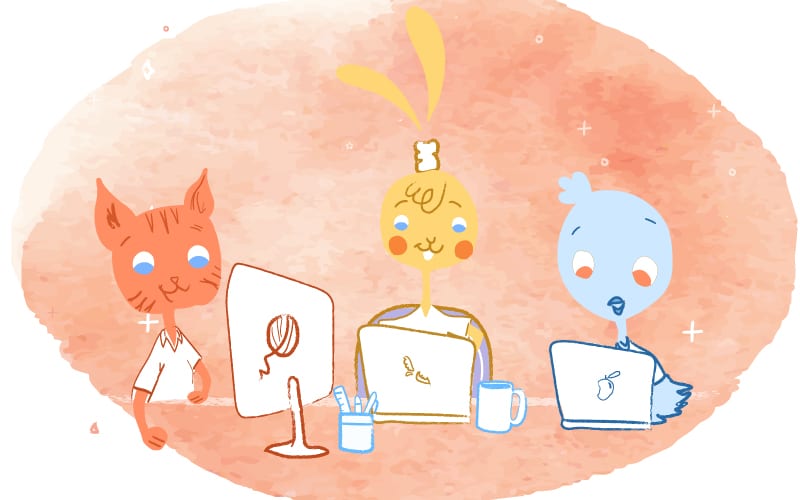

Is it difficult for you to stay focused during the winter? You’re not alone if you feel the winter blues or suffer from seasonal affective disorder (SAD). In fact, during this time, we tend to feel more gloomy and fall into a depression cycle. In turn, we may experience the following symptoms:
- Feeling sluggish, irritable, and low in energy
- An inability to concentrate, a loss of interest, and a lack of motivation
- A change in appetite and difficulty sleeping
- Feelings of hopelessness and suicidal thoughts
Obviously, these symptoms are going to impact your productivity negatively. As such, if you are experiencing SAD, please speak with your doctor. Moreover, you can also try these techniques to have a more productive winter.
1. Soak up the sun.
As you can imagine, this can be challenging during the winter months since the days are shorter, and it’s darker. However, try and get outside any time the sun shines. Another option would be to place your workspace as close to a window as possible.
Sunlight plays a major role in productivity and work performance, not to mention your overall quality of life, as reported in an article published in the Journal of Clinical Sleep Medicine.
2. Use light therapy.
There’s still hope if getting real sunlight isn’t an option. You can stay energized and productive with light therapy, states the National Institutes of Health (NIH). You don’t have to put much effort into it, either. While you’re eating breakfast, spend 30 minutes sitting in front of a light box you can easily purchase online.
An influential 1998 study published in Psychological Medicine found that such interventions increased happiness levels by 70% in just a few weeks. The happier you are, the more productive you are.
3. Schedule outdoor activities.
“It’s much harder to feel like your life provides the variation needed and desired when you stay inside all of the time,” writes Deanna Ritchie in a previous Calendar article. “Even a quick ‘nippy-cold-walk’ at lunch will boost your productivity and confidence for the long-haul afternoon.”
It’s precisely for that reason that outdoor breaks are so beneficial, and there’s no shortage of things to do outdoors that will relieve stress. In times of low motivation and productivity, treat yourself to these four outdoor activities.
- Go for a mindful stroll. When you’re stuck in a rut of working without motivation, take a walk outside. When you’re in a different environment, with low temperature, fresh air, natural sound, and sunlight, you’re in a different mindset than if you’re inside.
- Immerse yourself in nature-based activities. “Take a pilgrimage to the next level by seeking out activities designed for nature, like hiking or skiing on the weekend,” suggests Deanna. If you’re feeling stressed, you can trek out into the forest for a few hours and completely escape the stress.
- Return to your childhood. Physical and mental health are both important when you’re immersed in work for an extended period of time. Exercise can, however, become a chore over time and cause you more stress. Rather than dreading exercise, make it fun, like building a snowman or having a snowball fight.
- Head for the mountains. There are times when you need a longer break after a long work week – especially if you have a family. Choose an activity that is more involved and more exciting for you, such as sledding, skiing, or snowboarding. Find the nearest mountain resort to dust off those skis and relax from the stress of the day.
4. Take advantage of the cold.
Sickness and ailments have always been associated with cold weather. Winter may be gloomy, but colder weather may actually have some health benefits, such as:
- Researchers have shown that exercising in cold weather or shivering on a short walk may help burn more calories.
- Winter might make you more prone to colds. However, this study suggests that cold environments strengthen the immune system.
- The quality of sleep and speed of sleep can be improved by sleeping in a cold room, according to many studies.
- Cold temperatures can boost your brain activity and make you think more clearly during winter. If you’re planning to present at work during the winter, keep that in mind.
- As you exercise in the cold, your heart works twice as hard to keep you warm. So, if you want to keep active in the winter, a brisk run in the cold air might be beneficial. The winter can be dangerous for people with heart disease, however.
In addition to the health benefits listed above, you can also increase your productivity if you live somewhere where you cannot enjoy outdoor sports or picnics during the warmer seasons. How? Rather than thinking about what you will do after work or spending all day outside, you can stay focused.
Further, if you’re stuck inside, you can get a jump start on “spring cleaning.” For example, get rid of or delete anything you no longer need from your computer files and hard copy files. Or, declutter and organize your workspace. As a result, you’ll be less overwhelmed and less stressed.
5. Use a 15-minute list.
A 15-minute list can come in handy when you’ve got no desire to draft Tuesday’s team meeting on a cold, grey winter morning.
So, what exactly is a 15-minute list? It’s simply a list of things you can do in 15 minutes or less. Examples include scheduling a dentist appointment, preparing an agenda for your meeting, or responding to an email.
In short, these are easy, quick tasks that require little brain power and little effort.
By quickly crossing off items from your 15-minute list, your mojo and productivity are boosted. As you feel the warm glow of accomplishment, you are now ready to draft the team meeting presentation. Plus, you can use it to get work done while you’re waiting for Zoom meetings to start or for the tech help desk to answer your call.
So, if you’re unsure what to do or waiting for a Zoom call to begin, try checking off a few items on your 15-minute list.
6. Take time off for mental health.
Winter can be tough on your mental health, so plan ahead and take off sporadic days throughout the season to stay happy and healthy. During those cold months, they’ll not only give you something to look forward to but also give you time to reset your body and re-energize yourself.
In addition, a 2010 study in the Indian Journal of Occupational & Environmental Medicine noted that mental health issues can negatively impact productivity in the workplace, so taking some time off can be beneficial both to wellness and productivity.
7. Exercise mid-day.
In the mornings, it can be difficult to get motivated due to shorter daylight hours. As such, the thought of exercising can be even less appealing when the sun sets in the early evening.
In order to stay healthy, try a mid-day workout routine if you work from home (which is common these days). You can boost your energy level with a quick HIIT workout or a mind-boosting yoga practice.
Even if you’re stuck at the office, a quick 15-minute walk in the fresh air will boost your endorphin levels and make you more productive.
8. Work in vacation mode.
Take a moment to reflect on your last vacation. Describe what happened the week before you relaxed on a beach or traveled to a new country. How much work did you complete in a short period of time?
When we have a hard deadline, we often kick into high gear. By amplifying our productivity, we can hit the road in no time. And we don’t waste time on pointless tasks or procrastinate as much.
You’ll be more productive if you set mini-vacation deadlines, like turning off your computer at 5:30 instead of 6:30. You should also give yourself a reason to leave early. For example, having dinner with your family, taking an earlier gym class, or joining a book club.
In other words, make your workday shorter with a self-imposed mini-vacation. Just make sure that it’s something that you enjoy and look forward to.
9. Plan fun activities.
Despite the temptation to hibernate like a bear, don’t stay in an antisocial slump this time of year. Instead, consider taking a tropical vacation or a long weekend. It’s also a good idea to see people you care about and plan activities you’ll enjoy. Or, you can fill up your mental and emotional reserves as well by taking in cultural events during the winter.
Remember, job performance is heavily influenced by what we do outside of work hours. Besides providing us with the chance to recharge, research shows that anticipating plans can be more mentally stimulating than actually carrying them out. Compared to waiting for material goods, people were happier when waiting for an event or experience. It’s also the same when planning a vacation versus taking one.
10. Work on new, exciting projects.
It is the perfect time of year to start taking on projects that excite you, especially if your work has become dull. After all, you may feel drained and unproductive if you keep doing the same assignments.
If you want to spice things up at work, take on some new responsibilities. It will give you the extra boost you need to plow through the dreary winter months. However, if you already have a full plate, I wouldn’t overcommit yourself.
11. Make sure your task list is winterized.
If left unchecked, the tasks list can rapidly grow out of control.
So, just like you’ve winterized your car or home, now is the time to winterize your task list. And, in this case, that means trimming your to-do list.
Of course, that’s easier said than done. So, you might want to experiment with these strategies:
Pick your top-three priorities.
“Identify only three things you will do,” suggests Calendar co-founder John Hall. “When I say identify three things — You’re going to commit to yourself, and you are going to do it. Be cutthroat about this. As soon as we have more than seven options, our brains start getting overwhelmed.”
Use the 4Ds of time management.
The 4Ds of time management can be used to manage any input you receive, such as messages or meetings.
- Do. Don’t wait. Take action now.
- Delegate. A better qualified or more available person should be assigned the task.
- Defer. Schedule important but not urgent tasks for later.
- Delete. Although it’s often called a “drop,” it’s the same concept. Get rid of all those unimportant and unnecessary commitments.
Cross off half the things on your to-do list.
Take a moment to decide the ten things you’d like to eliminate from your list.
Follow the 2-minute rule.
This concept was introduced by David Allen in “Getting Things Done.”. When you can perform a task in less than two minutes, do so.
As James Clear explains, this technique can also be used to break old habits and stop procrastinating. For instance, instead of claiming to run three miles, tie your shoes instead.
Set time limits.
Parkinson’s Law states: “work expands to the time allotted for it.”
As an example, I might check my inbox around 11:00 in the morning,” Hall explains. As a result, I only have 30 minutes available to catch up on my morning emails.
12. Embrace coziness.
As you prepare for the evening, take advantage of early sunsets. Although Finland experiences dark winter days for up to 50 days in a row, The World Happiness Report ranks Finland as one of the happiest places on earth.
As they enjoy their quiet time, feel the warmth of the fire, and enjoy good food and friends in their homes, they find ways to appreciate and savor the quiet.
As soon as you’re done with your work for the day, disconnect from your devices and do something creative, like reading a book or pursuing a hobby that doesn’t require completion.
Featured Image Credit: Oziel Gómez: Pexels; Thank you!











Deanna Ritchie
Editor-in-Chief at Calendar. Former Editor-in-Chief and writer at Startup Grind. Freelance editor at Entrepreneur.com. Deanna loves to help build startups, and guide them to discover the business value of their online content and social media marketing.